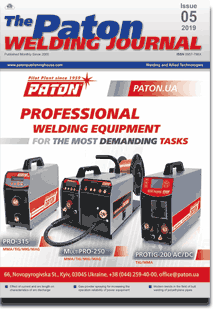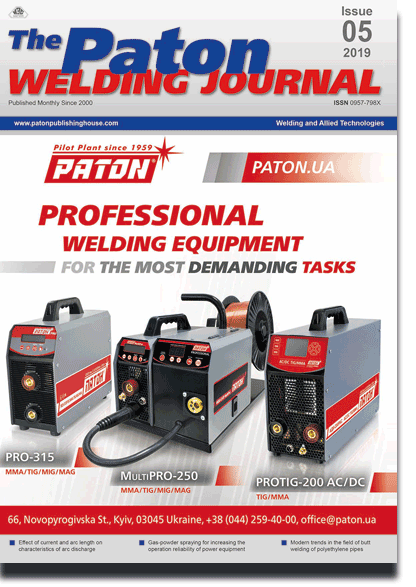| 2019 №05 (01) |
DOI of Article 10.15407/tpwj2019.05.02 |
2019 №05 (03) |

The Paton Welding Journal, 2019, #5, 13-17 pages
Journal The Paton Welding Journal
Publisher International Association «Welding»
ISSN 0957-798X (print)
Issue #5, 2019 (May)
Pages 13-17
Stress-strain state of welded and brazed assemblies from dissimilar materials with soft interlayer at thermal loading
V.V. Kvasnytskyi1, V.F. Kvasnytskyi2, M.V. Matvienko2, E.A. Buturlya2 and G.V. Yermolayev2
1National Technical University of Ukraine «Igor Sikorsky Kyiv Polytechnic Institute» 37 Peremohy Prosp., Kyiv-56, Ukraine. E-mail: kvas69@ukr.net
2National University of Shipbuilding 9 Heroiv Ukrainy Prosp., 54025, Mykolaiv, Ukraine. E-mail: welding@nuos.edu.ua
Computer modeling by finite element method was used to study the stress-strain state in joints of homogeneous materials under axial load. The studies were carried out taking into account plastic deformations in soft interlayers, which are usually used in diffusion welding to activate surfaces and reduce residual stresses. In brazing the intermediate layer is the braze weld, that differs from the base metal in its physical and mechanical properties. It is shown that along the butt, both in the metals being joined, and in the interlayer, equivalent stresses are distributed more uniformly than during elastic deformation. Plastic deformations in the interlayer are absent in the zone of stagnation (on the axis of the cylindrical assembly) and are almost linearly increased, reaching maximum values (about 6.5 %) at the outer cylindrical surface of the assembly. A high level of plastic deformations indicates the feasibility of using thermal loading in diffusion welding of dissimilar materials with soft interlayers. The degree of «softness» of the interlayer and its effect on the stress-strain state of the assembly during plastic deformation is mainly determined by its strength (yield limit) and almost does not depend on its rigidity (moludus of elasticity). 8 Ref., 1 Table, 10 Figures.
Keywords: welded and brazed assemblies, soft interlayer, computer modeling, stress-strain state, thermal loading
Received: 12.02.19
Published: 30.05.19
References
1. Bakshi, O.A., Kachanov, L.M. (1965) On stressed state of plastic interlayer under axisymmetric deformation. Izv. AN SSSR, Mekhanika, 2, 134-137 [in Russian].2. Bakshi, O.A., Shron, R.Z. (1971) On calculated evaluation of strength of welded joints with soft interlayer. Svarochn. Proizvodstvo, 3, 3-5 [in Russian].
3. Chigarev, A.V., Kravchuk, A.S., Smalyuk, A.F. (2004) ANSYS for engineers: Refer. Book. Moscow, Mashinostroenie-1 [in Russian].
4. Basov, K.A. (2005) ANSYS: User directory. Moscow, DMK Press [in Russian].
5. Kvasnytskyi, V.V., Kvasnytskyi, V.F., Dong Chunlin et al. (2018) Stressed state of welded and brazed assemblies from similar materials with a soft interlayer under axial loading. The Paton Welding J., 4, 6-10. https://doi.org/10.15407/tpwj2018.04.01
6. Kvasnytskyi, V.V., Yermolayev, H.V., Matviienko. M.V. (2017) Mechanics of bonds in diffusion welding, soldering and spraying of dissimilar materials under elasticity conditions. In: Monography. Nikolaev, NUK [in Russian].
7. Makhnenko, V.I., Kvasnitsky, V.V. (2009) Peculiarities of formation of stress-strain state in diffusion bonds between dissimilar materials. The Paton Welding J., 8, 7-11.
8. Ermolaev, G.V., Martynenko, V.A., Olekseenko, S.V. et al. (2017) Effect of the rigid interlayer thickness on the stress-strain of metal-graphite assemblies under thermal loading. Strength of Materials, 49(3), 422-428. https://doi.org/10.1007/s11223-017-9882-4
Suggested Citation
V.V. Kvasnytskyi, V.F. Kvasnytskyi, M.V. Matvienko, E.A. Buturlya and G.V. Yermolayev (2019) Stress-strain state of welded and brazed assemblies from dissimilar materials with soft interlayer at thermal loading. The Paton Welding J., 05, 13-17.The cost of subscription/purchase order journals or individual articles
| Journal/Currency | Annual Set | 1 issue printed |
1 issue |
one article |
| TPWJ/USD | 384 $ | 32 $ | 26 $ | 13 $ |
| TPWJ/EUR | 348 € | 29 € | 24 € | 12 € |
| TPWJ/UAH | 7200 UAH | 600 UAH | 600 UAH | 280 UAH |
| AS/UAH | 1800 UAH | 300 UAH | 300 UAH | 150 UAH |
| AS/USD | 192 $ | 32 $ | 26 $ | 13 $ |
| AS/EUR | 180 € | 30 € | 25 € | 12 € |
| SEM/UAH | 1200 UAH | 300 UAH | 300 UAH | 150 UAH |
| SEM/USD | 128 $ | 32 $ | 26 $ | 13 $ |
| SEM/EUR | 120 € | 30 € | 25 € | 12 € |
| TDNK/UAH | 1200 UAH | 300 UAH | 300 UAH | 150 UAH |
| TDNK/USD | 128 $ | 32 $ | 26 $ | 13 $ |
| TDNK/EUR | 120 € | 30 € | 25 € | 15 € |
AS = «Automatic Welding» - 6 issues per year;
TPWJ = «PATON WELDING JOURNAL» - 12 issues per year;
SEM = «Electrometallurgy Today» - 4 issues per year;
TDNK = «Technical Diagnostics and Non-Destructive Testing» - 4 issues per year.


